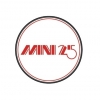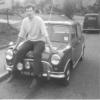If the finish feels rough (as opposed to being merely flat, but smooth) then I second the advice being given about needing to flatten the finish with sandpapers. If you have enough paint you should be able to carefully flatten the finish and polish it up - this is how virtually all painters get show quality finishes from cellulose (aka lacquer) paints. They are made to be color-sanded and polished.
You have to flatten it even if you decide to spray a fresh coat. The fresh coat won't magically fill the valleys up the peaks of the roughness - it will more or less evenly coat the rough peaks, leaving you with a surface that is still uneven, though it might be a bit smoother.
As far as respraying a fresh coat and the ultimate cause of the roughness - I doubt it is due to pressure. What's the temperature you are spraying at? A vital factor when spraying cellulose/lacquer is the drying speed of the thinner used. Typically the finishing thinners for automotive quality cellulose are available in fast, medium, and slow drying speeds.
Fast thinners are good for cold temperatures and primers. They evaporate quicker, and some roughness is no big deal for a primer since those will be sanded anyway (and the faster drying lets you get to work sooner.)
But using a "fast" thinner for the final gloss coats risks it drying prematurely (i.e. while being atomized by the spray gun) and this will cause the very effect of making it look like overspray particles are all over the finish - because the paint literally dried before it hit the finish surface. This is even more likely to happen if you sprayed it in warm temperatures.
If the temperatures are fairly cold, you can adjust by using a medium thinner, but if you use a fast thinner under warm temperature conditions, there's a high likelihood of it drying prematurely and causing the overspray-like roughness effect.
Other possible causes might be holding the spray gun too far from the surface when spraying - one rule of thumb is no more than a hand's width space between the gun nozzle and the spray surface, and always keep the distance constant by locking your wrist and not using wrist action to arc the gun from side to side.


















